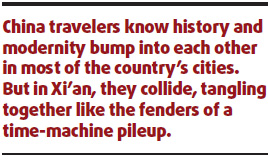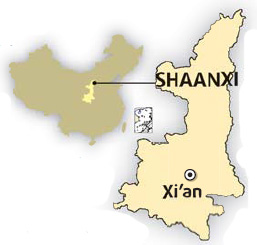|

The serene Qujiang Lake ripples across about a third of the 100-sq-km park. The site is constellated by 66 attractions, including gardens, monuments and pagodas - all infused with all things Tang.
Up to 600 visitors pack the Phoenix Theater to catch daily performances of the Dream Back to the Tang Dynasty dance drama, which features technicolored costumes and dazzling choreography.
The park also hosts one of the world's largest water-screen cinemas. A cartoon version of Journey to the West is projected on a 120-m-wide wall of fountain spray every night. Lasers and pyrotechnics contribute to the multimedia character of the program, which opens with a parade of live dynastic characters perched atop gliding neon-lit floats.
Tang Paradise's water-and-light show actually outshines that of Asia's largest fountain, located a few km eastward. Visitors can walk among eight isles inside the fountain, strolling among its 2,004 nozzles and 3,000 multicolored light bulbs as water spurts in tempo with classical music.

Towering above the fountain is the seven-story Big Wild Goose Pagoda. The 64-m-high building warehoused the scriptures Xuan Zang - the monk portrayed in Journey to the West - brought from India.
Tang Emperor Gao Zong originally ordered it constructed as a five-story memorial to his mother in AD 652. After an earthquake caused the top two floors to cave in, it was rebuilt to its current height in AD 704. But the quake left the spire tilting 1 m east, making it look like the Chinese version of the Leaning Tower of Pisa.
The name comes from a legend about famished monks. Their prayers for meat seemed to have been answered when a giant goose hurtled from the heavens, crashing dead at their feet. But fearing it was actually a god rather than an oversized gander, they buried - rather than ate - the bird at the site.
A few km to the east stands the 15-story, 43-m-high Small Goose Pagoda.
Built around AD 708 under Tang Emperor Zhong Zong, the structure stood 2 m higher before the 1556 Shaanxi earthquake. Ancient Indian monks would make pilgrimages to the spire with Buddhist scriptures from their homeland in hand.
The pagoda shadows the Xi'an Museum, which showcases the city's development since prehistory.
More than 2,000 displays strewn among seven exhibition halls show the internationalization of the Silk Road's terminus.
In addition to distinctly Chinese artifacts, many displays come from faraway lands that traded in ancient Xi'an.
The most intriguing items fuse the Chinese and foreign elements. In carvings covering a stone coffin for a Greek man who died in the city during the Tang Dynasty, Buddhas chat with angels, and Chinese musicians perform in front of a Pegasus.
The museum is situated just south of the city wall's main gate.
First constructed in 194 BC and expanded until the Ming Dynasty (1368-1644), the bulwark built to repel foreign soldiers now attracts legions of tourists from afar.
The 12-m-high wall wraps 11.9 km around the city. Its 15-18 m width makes it ideal for cycling, and there are plenty of spots among the guard towers where visitors can rent bikes.
Tucked inside the wall's main gate is the city's main nightlife corridor, Defuxiang.
Some of the bars flanking this cobblestone street play up the kitsch, while others are no-frills watering holes. There seems to be little that falls in between.
A pair of stern Terracotta Warriors guards the entrance of Marco Polo Bar, while the walls of Old Henry's Bar are covered with cowboy hats, bull skulls and revolvers.
Back Nook Bar is a utilitarian collection of tables and chairs, save for a gutted telephone booth stuck in a corner.
While the Terracotta Warriors have marched to the top spot of most travel itineraries, Xi'an's visitors will discover a bonanza of other historical and modern marvels that make the journey all the more worthwhile.
By Erik Nilsson
|

